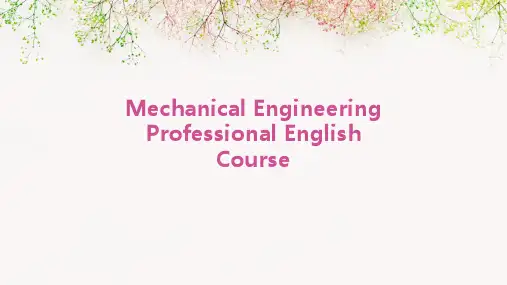机械工程专业英语教程 (33)[17页]
- 格式:ppt
- 大小:4.73 MB
- 文档页数:17
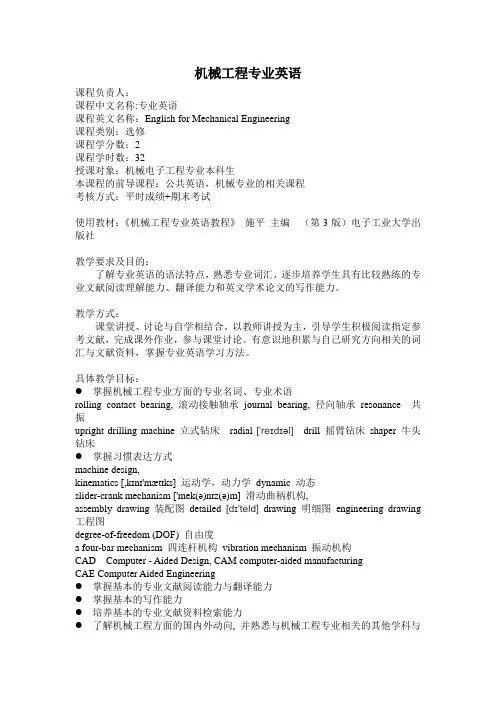
机械工程专业英语课程负责人:课程中文名称:专业英语课程英文名称:English for Mechanical Engineering课程类别:选修课程学分数:2课程学时数:32授课对象:机械电子工程专业本科生本课程的前导课程:公共英语,机械专业的相关课程考核方式:平时成绩+期末考试使用教材:《机械工程专业英语教程》施平主编(第3版)电子工业大学出版社教学要求及目的:了解专业英语的语法特点,熟悉专业词汇,逐步培养学生具有比较熟练的专业文献阅读理解能力、翻译能力和英文学术论文的写作能力。
教学方式:课堂讲授、讨论与自学相结合。
以教师讲授为主,引导学生积极阅读指定参考文献,完成课外作业,参与课堂讨论。
有意识地积累与自己研究方向相关的词汇与文献资料,掌握专业英语学习方法。
具体教学目标:●掌握机械工程专业方面的专业名词、专业术语rolling contact bearing, 滚动接触轴承journal bearing, 径向轴承resonance 共振upright drilling machine 立式钻床radial ['reɪdɪəl]drill 摇臂钻床shaper 牛头钻床●掌握习惯表达方式machine design,kinematics [,kɪnɪ'mætɪks] 运动学,动力学dynamic 动态slider-crank mechanism ['mek(ə)nɪz(ə)m] 滑动曲柄机构,assembly drawing 装配图detailed [dɪ'teld]drawing 明细图engineering drawing 工程图degree-of-freedom (DOF) 自由度a four-bar mechanism 四连杆机构vibration mechanism 振动机构CAD Computer - Aided Design, CAM computer-aided manufacturingCAE Computer Aided Engineering●掌握基本的专业文献阅读能力与翻译能力●掌握基本的写作能力●培养基本的专业文献资料检索能力●了解机械工程方面的国内外动向, 并熟悉与机械工程专业相关的其他学科与知识Lesson 1 Translation Skill of Subject-Based English ESP(专门用途英语即专业英语)——English For Specific [spə'sɪfɪk] PurposesEST(科技英语)——English for Science and TechnologyEBE(商业经济英语)——English for Business and EconomicsESS(社会科学英语)——English for Social ScienceEAP(学术英语)——English for Academic PurposesEOP(职业英语)——English for Occupational PurposesESP的语法特点:●名词化●被动语态(1)名词化:The rocket has been developed. For this reason, man can enter space.The development of the rocket makes it possible for man to enter space.随着火箭技术的进步,人类进入太空成为可能。

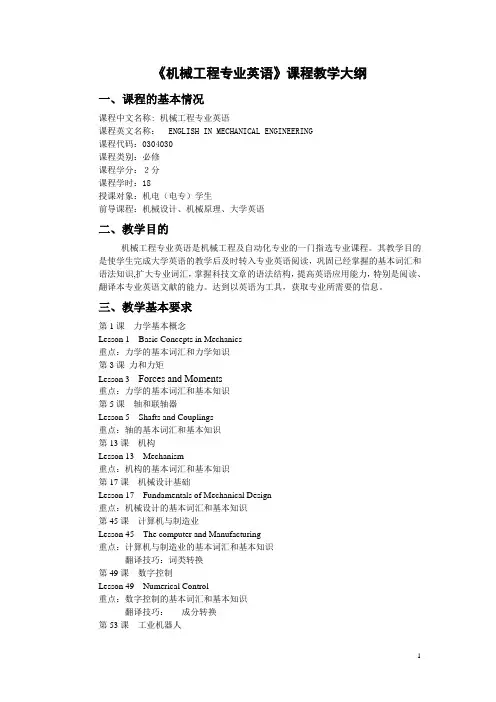
《机械工程专业英语》课程教学大纲一、课程的基本情况课程中文名称: 机械工程专业英语课程英文名称: ENGLISH IN MECHANICAL ENGINEERING课程代码:0304030课程类别:必修课程学分:2分课程学时:18授课对象:机电(电专)学生前导课程:机械设计、机械原理、大学英语二、教学目的机械工程专业英语是机械工程及自动化专业的一门指选专业课程。
其教学目的是使学生完成大学英语的教学后及时转入专业英语阅读,巩固已经掌握的基本词汇和语法知识,扩大专业词汇,掌握科技文章的语法结构,提高英语应用能力,特别是阅读、翻译本专业英语文献的能力。
达到以英语为工具,获取专业所需要的信息。
三、教学基本要求第1课力学基本概念Lesson 1 Basic Concepts in Mechanics重点:力学的基本词汇和力学知识第3课力和力矩Lesson 3 Forces and Moments重点:力学的基本词汇和基本知识第5课轴和联轴器Lesson 5 Shafts and Couplings重点:轴的基本词汇和基本知识第13课机构Lesson 13 Mechanism重点:机构的基本词汇和基本知识第17课机械设计基础Lesson 17 Fundamentals of Mechanical Design重点:机械设计的基本词汇和基本知识第45课计算机与制造业Lesson 45 The computer and Manufacturing重点:计算机与制造业的基本词汇和基本知识翻译技巧:词类转换第49课数字控制Lesson 49 Numerical Control重点:数字控制的基本词汇和基本知识翻译技巧:成分转换第53课工业机器人Lesson53 Industrial Robots重点:工业机器人的基本词汇和基本知识翻译技巧:掌握相应专业词汇第55课机器人系统的组成部分Lesson 55 Components of a Robot System重点:机器人系统的基本词汇和基本知识翻译技巧成分转换第57课工程师在机械制造业中的作用Lesson 57 The Roles of Engineers in Manufacturing重点:机械制造的基本词汇和基本知识翻译技巧状语从句的译法第59课信息时代的机械工程Lesson 59 Mechanical Engineering in the Information Age重点:机械工程的基本词汇和基本知识翻译技巧成分分译第61课如何撰写科学论文Lesson 61 How to Write a Scientific Paper重点:科学论文写作的基本词汇和基本知识翻译技巧长句分析四、课程内容与学时分配五、教材与参考书教材:《机械工程专业英语》,施平编,哈工大出版社,2007参考书:《机械工程英语》,陈道礼、刘旺、夏绪辉编,武汉科技大学机械自动化学院六、教学方式和考核方式1、教学方式:以课堂讲授为主,辅以课后作业。
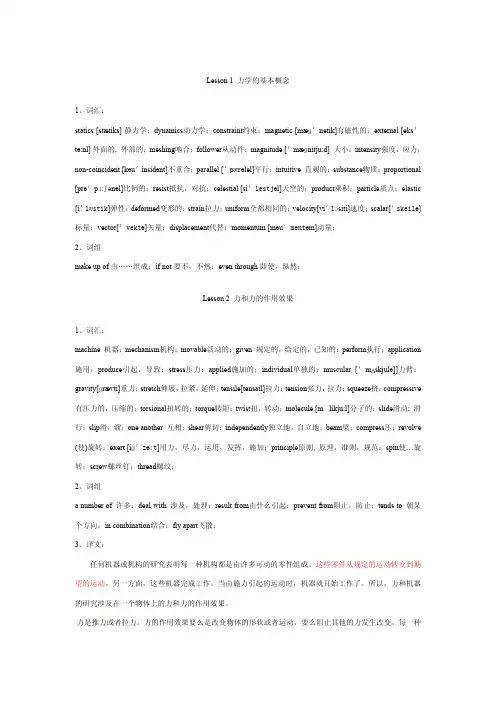
Lesson 1 力学的基本概念1、词汇:statics [stætiks] 静力学;dynamics动力学;constraint约束;magnetic [mæɡ'netik]有磁性的;external [eks'tə:nl] 外面的, 外部的;meshing啮合;follower从动件;magnitude ['mæɡnitju:d] 大小;intensity强度,应力;non-coincident [kəu'insidənt]不重合;parallel ['pærəlel]平行;intuitive 直观的;substance物质;proportional [prə'pɔ:ʃənəl]比例的;resist抵抗,对抗;celestial [si'lestjəl]天空的;product乘积;particle质点;elastic [i'læstik]弹性;deformed变形的;strain拉力;uniform全都相同的;velocity[vi'lɔsiti]速度;scalar['skeilə]标量;vector['vektə]矢量;displacement代替;momentum [məu'mentəm]动量;2、词组make up of由……组成;if not要不,不然;even through即使,纵然;Lesson 2 力和力的作用效果1、词汇:machine 机器;mechanism机构;movable活动的;given 规定的,给定的,已知的;perform执行;application 施用;produce引起,导致;stress压力;applied施加的;individual单独的;muscular ['mʌskjulə]]力臂;gravity[ɡrævti]重力;stretch伸展,拉紧,延伸;tensile[tensail]拉力;tension张力,拉力;squeeze挤;compressive 有压力的,压缩的;torsional扭转的;torque转矩;twist扭,转动;molecule [m likju:l]分子的;slide滑动; 滑行;slip滑,溜;one another 互相;shear剪切;independently独立地,自立地;beam梁;compress压;revolve (使)旋转;exert [iɡ'zə:t]用力,尽力,运用,发挥,施加;principle原则, 原理,准则,规范;spin使…旋转;screw螺丝钉;thread螺纹;2、词组a number of 许多;deal with 涉及,处理;result from由什么引起;prevent from阻止,防止;tends to 朝某个方向;in combination结合;fly apart飞散;3、译文:任何机器或机构的研究表明每一种机构都是由许多可动的零件组成。


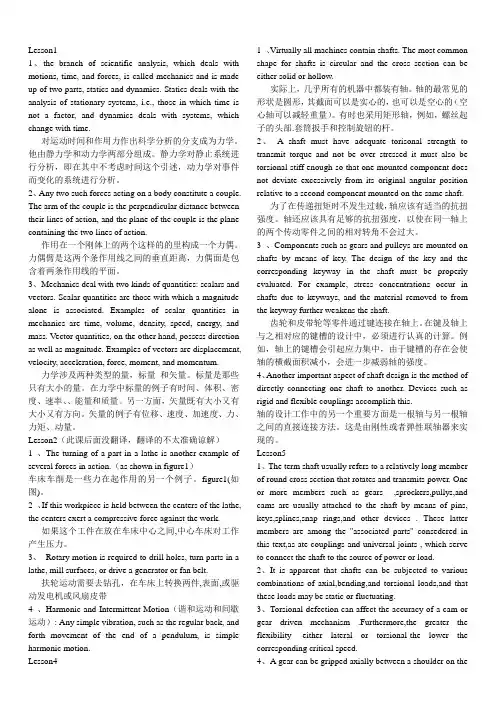
Lesson11、the branch of scientific analysis, which deals with motions, time, and forces, is called mechanics and is made up of two parts, statics and dynamics. Statics deals with the analysis of stationary systems, i.e., those in which time is not a factor, and dynamics deals with systems, which change with time.对运动时间和作用力作出科学分析的分支成为力学。
他由静力学和动力学两部分组成。
静力学对静止系统进行分析,即在其中不考虑时间这个引述,动力学对事件而变化的系统进行分析。
2、Any two such forces acting on a body constitute a couple. The arm of the couple is the perpendicular distance between their lines of action, and the plane of the couple is the plane containing the two lines of action.作用在一个刚体上的两个这样的的里构成一个力偶。
力偶臂是这两个条作用线之间的垂直距离,力偶面是包含着两条作用线的平面。
3、Mechanics deal with two kinds of quantities: scalars and vectors. Scalar quantities are those with which a magnitude alone is associated. Examples of scalar quantities in mechanics are time, volume, density, speed, energy, and mass. Vector quantities, on the other hand, possess direction as well as magnitude. Examples of vectors are displacement, velocity, acceleration, force, moment, and momentum.力学涉及两种类型的量,标量和矢量。
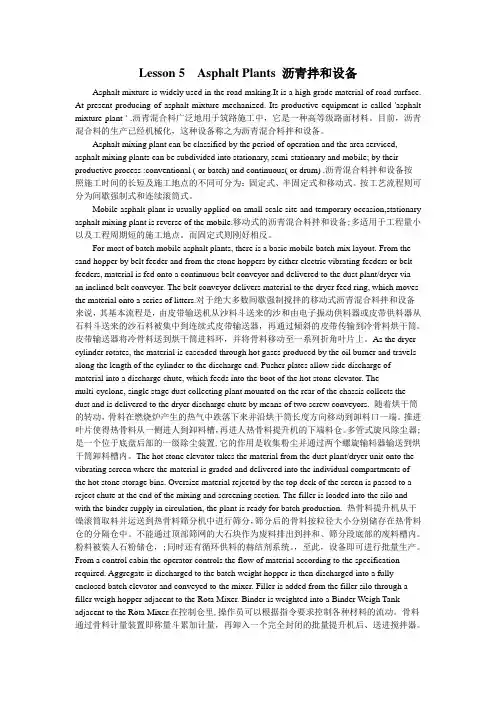
Lesson 5 Asphalt Plants 沥青拌和设备Asphalt mixture is widely used in the road making.It is a high grade material of road surface. At present producing of asphalt mixture mechanized. Its productive equipment is called 'asphalt mixture plant ' .沥青混合料广泛地用于筑路施工中,它是一种高等级路面材料。
目前,沥青混合料的生产已经机械化,这种设备称之为沥青混合料拌和设备。
Asphalt mixing plant can be classified by the period of operation and the area serviced, asphalt mixing plants can be subdivided into stationary, semi-stationary and mobile; by their productive process :conventional ( or batch) and continuous( or drum) .沥青混合料拌和设备按照施工时间的长短及施工地点的不同可分为:固定式、半固定式和移动式。
按工艺流程则可分为间歇强制式和连续滚筒式。
Mobile asphalt plant is usually applied on small scale site and temporary occasion,stationary asphalt mixing plant is reverse of the mobile.移动式的沥青混合料拌和设备;多适用于工程量小以及工程周期短的施工地点。
而固定式则刚好相反。
![机械工程专业英语教程 (第5版)课件 (32)[12页]](https://uimg.taocdn.com/b8e0b326be1e650e53ea994c.webp)
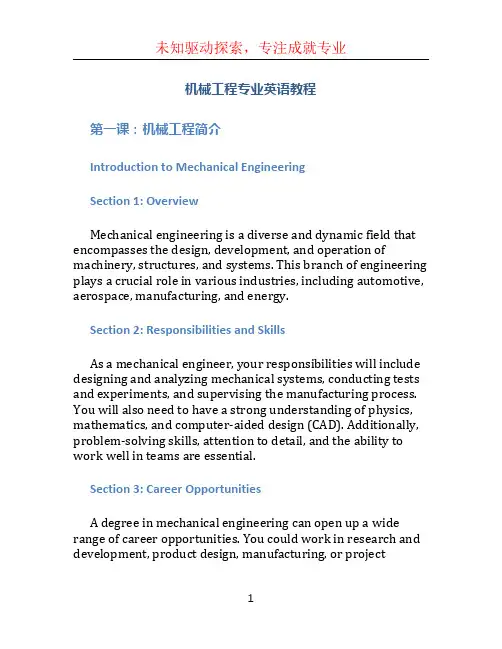
机械工程专业英语教程第一课:机械工程简介Introduction to Mechanical EngineeringSection 1: OverviewMechanical engineering is a diverse and dynamic field that encompasses the design, development, and operation of machinery, structures, and systems. This branch of engineering plays a crucial role in various industries, including automotive, aerospace, manufacturing, and energy.Section 2: Responsibilities and SkillsAs a mechanical engineer, your responsibilities will include designing and analyzing mechanical systems, conducting tests and experiments, and supervising the manufacturing process. You will also need to have a strong understanding of physics, mathematics, and computer-aided design (CAD). Additionally, problem-solving skills, attention to detail, and the ability to work well in teams are essential.Section 3: Career OpportunitiesA degree in mechanical engineering can open up a wide range of career opportunities. You could work in research and development, product design, manufacturing, or projectmanagement. Mechanical engineers are in demand in almost every industry, ensuring a stable and rewarding career path.Section 4: University CoursesTo become a mechanical engineer, it is essential to pursue a degree in mechanical engineering from a reputable university. The curriculum typically includes courses in engineering principles, materials science, thermodynamics, fluid mechanics, and mechanical design. Additionally, practical training through internships or cooperative education programs is crucial for gaining hands-on experience.Section 5: ConclusionMechanical engineering offers a challenging and rewarding career for those with a passion for solving problems and a desire to create innovative solutions. With the right education and skills, you can embark on a successful journey in the field of mechanical engineering. Remember, the possibilities are endless in this ever-evolving discipline.第二课:机械设计基础Fundamentals of Mechanical DesignSection 1: IntroductionIn this lesson, we will explore the fundamentals of mechanical design. Mechanical design involves the creation and development of physical systems and components that meet specific requirements and specifications. This processrequires a deep understanding of materials, mechanics, and engineering principles.Section 2: Design ProcessThe design process typically follows a systematic approach that includes several stages. These stages include problem identification, conceptual design, detailed design, manufacturing, and testing. Each stage involves various activities such as brainstorming, prototyping, and evaluation.Section 3: Design ConsiderationsDuring the design process, there are several important considerations to keep in mind. These include functionality, efficiency, reliability, safety, and cost-effectiveness. It is also crucial to consider the environmental impact and sustainability of the design.Section 4: Tools and SoftwareTo aid in the design process, engineers use various tools and software. Computer-aided design (CAD) software allows for precise modeling and simulation of mechanical systems. Finite element analysis (FEA) software helps in analyzing the structural integrity and performance of designs.Section 5: Case StudyTo further understand the application of mechanical design principles, we will examine a case study. This real-world example will demonstrate how the design process isimplemented to solve a specific problem and achieve desired outcomes.Section 6: ConclusionMechanical design is a critical aspect of mechanical engineering. It requires a combination of creativity, technical knowledge, and attention to detail. By mastering the fundamentals of mechanical design, you will be well-equippedto tackle complex challenges and contribute to the development of innovative solutions.以上是《机械工程专业英语教程》的课文翻译。
